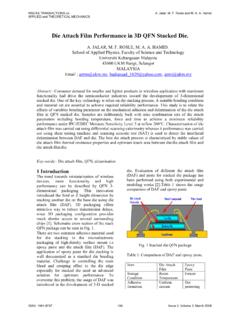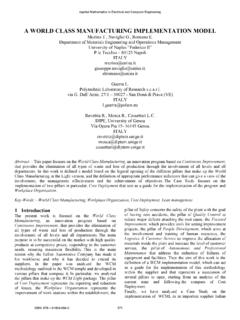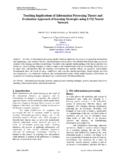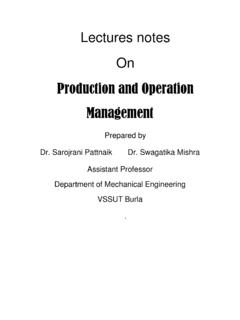Transcription of MATERIAL MANAGEMENT BY USING LEAN …
1 MATERIAL MANAGEMENT BY USING lean manufacturing PRINCIPLES A CASE STUDY A. C. Yamagar1 and P. M. Ravanan2 1PG Scholar, Dept of Production Engineering, Matunga Mumbai 2 Dept. Of Production Engineering Matunga Mumbai-400019 ABSTRACT: MATERIAL MANAGEMENT and inventory control, or more precisely controlling flow of MATERIAL is considered as last frontier of profit in profit making manufacturing organization. But in order to reduce the cost burden and make the organization more cost effective, even non profit organization such as government agencies, public utilities, hospitals and educational institutions have begun to realize its importance. MATERIAL MANAGEMENT and inventory control therefore are primarily concerned with the flow of MATERIAL within and from an organization and in manufacturing industries. This paper reviews how flow of MATERIAL is managed by USING some lean manufacturing techniques. The focus in lean manufacturing is to reduce the wastes and make the system more efficient.
2 Managing the flow of MATERIAL with lean principles leads to saving in time, inventory and cost. Keywords: MATERIAL MANAGEMENT , lean manufacturing , Inventory control, INTRODUCTION: The primary goal of any business is to make a profit. In order to achieve more profits either to increase the revenue or decrease the costs involved in manufacturing . Decreasing the cost is the better option than increasing revenue because capacity of plant is fixed and price has to be increase, but due to the competitor in the market it may not be possible. Decreasing the cost in manufacturing is possible through lean approach. lean manufacturing is the philosophy to reduce the wastes in manufacturing . The first time that lean concept was shown to the world was in the book the machine that changed the world which is a benchmark among craft production, mass production and lean production. The lean manufacturing technique was built in between 1945 and lean system helped to sustain Toyota in 1975, 1976, 1977 more than at other Japanese companies.
3 The origin of lean thinking came from the shop floor of Toyota motor corporation where a set of tool kit is developed such as JIT, pull production, one piece flow, visual control, KAIZEN, Cellular manufacturing , Inventory control(1). MATERIAL MANAGEMENT : In majority of the organizations, the cost of MATERIAL forms a substantial part of the selling price pf the product. The interval between receiving the purchased parts and transforming them in to final products varies from industries to industries depending upon the cycle time of manufacture. Materials are procured and held in the form of inventories. It is therefore necessary to hold inventories of various kinds to act as a buffer between supply and demand for efficient operation of the system. Thus, an effective control becomes a must for smooth and efficient running of the production cycle with least interruptions. The stocking of anything that is tangible in order to meet the future demand is the subject matter of the inventory theory(2).
4 The MATERIAL MANAGEMENT expert like Dean Ammer claim rightly that efforts for saving rupee in materials cost is almost equal to the efforts made for additional sale of Rs. 10. Materials form an important part of current assets in any organization. The return on investment depends on great deal on the manner of utilization of MATERIAL . The relationship is as represented bellow. Profit ROI= Fixed asset X Current asset The fixed asset constitute capital already sunk and the only scope for improving the return on investment lies therefore in efficient MANAGEMENT of materials which constitute the bulk of the current assets. Therefore in this context, the Proceedings of the 2nd International Conference on manufacturing Engineering, Quality and Production SystemsISSN: 1792-4693104 ISBN: 978-960-474-220-2control of materials assumes great importance(3).
5 lean PRINCIPLES: Ever since Henry Ford invented the assembly line, industrial innovators have constantly focused on improvement through a variety of different manufacturing strategies. lean manufacturing is a manufacturing strategy that seeks to produce a high level of throughput with a minimum of inventory. Originally a Japanese methodology known as the Toyota Production System designed by Sakichi Toyoda, lean manufacturing centers around placing small stockpiles of inventory in strategic locations around the assembly line, instead of in centralized warehouses. These small stockpiles are known as kanban, and the use of the kanban significantly lowers waste and enhances productivity on the factory floor. In addition to eliminating waste, lean manufacturing seeks to provide optimum quality by building in a method whereby each part is examined immediately after manufacture, and if there is a defect, the production line stops so that the problem can be detected at the earliest possible time One of the primary focuses of lean manufacturing is to eliminate waste; that is, anything that does not add value to the final product gets eliminated.
6 In this respect, large inventories are seen as a type of waste that carries with it a high cost. A second major focus is to empower workers, and make production decisions at the lowest level possible. lean manufacturing is defined as "a systematic approach to identifying and eliminating waste (non-value-added activities) through continuous improvement by flowing the product at the pull of the customer in pursuit of perfection". The goal of lean manufacturing is "to eliminate the eight wastes of lean -overproduction, motion, inventory, waiting, transportation, defects, underutilized people, and extra processing. lean targets non-value-added activities. These are the same activities that contribute to poor product quality"(5). lean thinking exposes these root causes that will need to be solved in order to eliminate the problems that they cause. The manufacturing process will become for efficient and consistent as these problems are solved.
7 Table 1 shows the difference between lean organization and traditional organization. lean manufacturing leads to the standardization of processes that can insure that improvements are consistently maintained. Of course these standards are not set in stone, but constantly challenged to see if further improvements can be made. The key lean manufacturing principles:: 1)One piece flow/ Cellular manufacturing : One-piece flow is defined as moving/ making only what is needed, when it is needed thus minimizing WIP inventory enhances efficiency, eliminates quick response time, eliminates build-up of defects and facilitates standardized work. To implement one piece flow Line should be properly balanced. In cellular manufacturing , production work stations and equipment are arranged in a product-aligned sequence that supports a smooth flow of materials and components through the production process with minimal transport or delay.
8 2) Batch Size Reduction: Historically, manufacturing companies have operated with large batch sizes in order to maximize machine utilization, assuming that changeover times were fixed and could not be reduced. Because lean calls for the production of parts to customer demand, the ideal batch size is ONE. However, a batch size of one is not always practical, so the goal is to practice continuous improvement to reduce the batch size as low as possible. Reducing batch sizes reduces the amount of work-in-process inventory (WIP). Not only does this reduce inventory-carrying costs, but also production lead-time or cycle time is approximately directly proportional to the amount of WIP(6). Proceedings of the 2nd International Conference on manufacturing Engineering, Quality and Production SystemsISSN: 1792-4693105 ISBN: 978-960-474-220-2 Table 1: Comparison between traditional organization and lean organization 3) Takt time: Takt time refers to the rate at which customers are buying products from the production line, the unit production rate that is needed to match customer requirements.
9 It is calculated by dividing the total available time per day by the daily customer demand (7)..4) Standard work: The goal of TPS (Toyota Production System) is to create an efficient production sequence that emphasizes human motion and the elimination of waste. Focused around human movements, standardized work outlines efficient, safe work methods and helps eliminate waste while maintaining quality. Standardized work is the foundation for Kaizen, or process improvement, in production. It organizes and defines worker movements. This is important because, when the work sequence is different each time and/or if the motions are disorganized, there is no base line for evaluation. The first step in kaizen is standardization (8). 5) Jidoka: Jidoka is defined as a system of ensuring that defect-free product is passed from one operation to the next. Quality is designed into the operation beginning at the product/equipment design phase utilizing prevention techniques.
10 Standard work supports tasks that involve exercising human judgement. Two common prevention techniques are Pokayoke and Andon(9). A Pokayoke is an element of the process that senses a defect or non-conformance and will not allow the process to proceed. Examples of Pokayoke include fixture features that will not accept an out-of-spec part, sensoring that checks for parts or features from previous operations, or sensoring/clamping in the process that will not release the part if it is not properly processed. Andons are visual displays such as lights, flags, etc. which indicate the operating status of a work centre. For example, a green light may indicate a cell is on schedule and is meeting takt time, a yellow light may indicate a cell is behind schedule or that an operator is calling for help with a problem, and a red light may indicate a cell has been stopped(10). 6) 5S(House keeping): 5S is a system to reduce waste and optimize productivity through maintaining an orderly workplace and USING visual cues to achieve more consistent operational results.












